Helping to Solve America’s Affordable Housing Problem

America is facing a serious affordable housing problem, a problem with wide-ranging implications for equality of opportunity and the long-term health of our communities. There isn’t enough affordable housing within sustainable communities—those that provide residents with quality opportunities for employment, health and wellness, and education—and there isn’t enough integrated access to such opportunities in communities that already offer affordable housing.
Solving this problem will take new kinds of partnerships, innovations, and cross-sector collaborations that holistically serve communities and the residents within them. Toward that end, Fannie Mae has launched a two-year, $10 million Sustainable Communities Innovation Challenge (The Challenge).
Understanding the Problem
America’s current affordable housing problem differs from historical trends. For more than 100 years, the general pattern across America worked roughly like this: People pursued economic opportunity by moving from one place to another. New housing was built to accommodate them, and communities grew in part by supplying affordable places to live for workers at many different income levels.
Recently, a different trend has taken hold, both across the country and within many metropolitan areas. Housing prices are spiking in areas with high levels of economic opportunity, and those areas are building more high-end housing to meet that demand—effectively pricing a wide range of lower-wage and/or lower-skilled workers out of those markets. Too often, this means that less-affluent people wind up excluded from particular neighborhoods and communities, with all of the shared amenities these provide—quality jobs, schools, parks, health care, etc.
On the one hand, housing experts will tell you that this problem isn’t radically new. It’s been happening in neighborhoods within cities for years. On the other hand, it’s now happening at an alarming rate and scale across the country. In a recent scholarly article, experts from the University of Southern California and the University of Pennsylvania summed the problem up as follows: “At the beginning of the 21st century, the US economy offers opportunities, but they are increasingly concentrated in cities and neighborhoods within cities that are not accessible to all.” There’s opportunity, but many people are effectively excluded from it.
Seeking Innovative Solutions
Fannie Mae launched the Sustainable Communities Innovation Challenge to help identify potential solutions to this complex problem. Recognizing that the affordable housing crisis is inextricably linked to adjacent sectors, The Challenge aims to attract promising ideas from a broad range of sectors and fields to advance Fannie Mae’s mission of creating housing opportunities that are safe, sustainable, and affordable across the country.
The first phase of The Challenge (which Arabella is helping to manage) seeks ideas that can help drive change at the intersection of affordable housing and employment/economic opportunity. Through this first phase, Fannie Mae seeks ideas to:
- Expand access to affordable housing in sustainable communities where strong employment opportunities are typically accompanied by high housing costs; and
- Improve access to quality employment opportunities for residents of existing affordable housing, while making sure housing is affordable to more people.
While numerous experts and other stakeholders are already aware of the affordable housing problem and working to address it, much more can be done. Fannie Mae is looking for innovative ideas that it, working with partners from within and beyond the traditional housing sector, can ultimately scale.
With that in mind, if you or those you know have ideas that will help Fannie Mae create greater access to affordable housing in sustainable communities, they want to hear from you.
